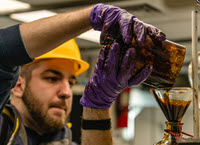
Scientists can use radium isotopes, which are released from oil in seawater and decay at a specific rate, as geochemical tracers to investigate marine processes involved in oil degradation. Matthew Kurpiel is investigating how radium isotopes in surface oil slicks and underwater oil plumes release into the surrounding seawater over time. His findings will help develop a tool to determine how long oil spill material will persist in the marine environment after it is released and track where it goes.
Matt is a master’s student with Coastal Carolina University’s Department of Coastal & Marine Systems Science and a GoMRI Scholar with the project Radium Isotope Release from Oil Degradation: Development of an ‘Oil Clock.’
His Path
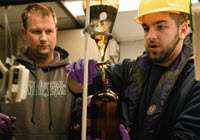
As a teenager, Matt was afraid of open water but challenged himself to go scuba diving during a family trip to Mexico. The surreal experience inspired him to pursue a science career where he could continue having exciting and challenging experiences. As a marine science undergraduate student at Coastal Carolina University, Matt assisted Dr. Richard Peterson on projects using radium isotopes as tracers for various marine processes. Dr. Peterson invited him to continue this work as a graduate student. “Many times, I recall vivid images of the Deepwater Horizon spill that were shown in the media. The memory of the horrific impacts that such a disaster can have motivates me to work towards research that can help mitigate future oil spill events,” said Matt. “This project is the culmination of an idea that Dr. Peterson has been working on for years. I’m just glad to be a part of it and learn from him and the process.”
His Work
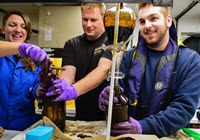
Matt’s research utilizes archived oil collected directly above the Macondo wellhead and oil collected by the ROV Odysseus from a natural seafloor oil seep field (GC600). He prepared oil-seawater mixtures (1 g oil to 10 L seawater ratio, approximating hydrocarbon concentrations measured in Deepwater Horizon sub-surface plumes) for each oil type, incubated them, and observed how radium isotopes released into the surrounding seawater over time and under different conditions. The incubations included an ocean surface treatment (outdoors in ambient sunlight) or a deep-sea treatment (5° C in dark refrigerators) to control for photodegradation processes and with live or compromised microbes to control for microbial biodegradation. Matt measured radium levels at multiple time points using alpha and gamma spectrometry.
Matt focuses on the radium isotope Ra-224, one of the only radium isotopes found in oil that is abundant and detectable immediately after sample collection. His observations so far revealed that the Ra-224 release signature exhibited only minor differences between the surface ocean and deep-sea treatments. This outcome surprised Matt and his colleagues, who predicted that the combined photodegradation and biodegradation processes in surface conditions would yield much higher Ra-224 activity than sunless, cold conditions. Treatments using compromised microbes showed higher Ra-224 activity than expected, including in deep-sea treatments where lack of light and microbes should have inhibited most or all degradation. “These results were surprising, as we expected degradation processes driven by sunlight and microbes to be the main control on radium release,” said Matt. “Our results suggest that degradation processes may play some role but other factors, such as ion exchange, may be at play as well.”
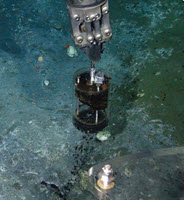
Matt observed that, for both oil types, Ra-224 activity typically peaked within the first 24 – 48 hours followed by a decline for the remaining incubation period. However, mixtures using Macondo wellhead oil showed consistently higher Ra-224 activity than mixtures using freshly collected oil from a seafloor seep. “We currently hypothesize that different oil sources (presumably from different subsurface reservoirs) vary in inherent radioactivity,” said Matt. “Previous literature shows that biodegradation does happen in the oil reservoir itself before the oil ever touches the water column, so one theory is that the oil from the natural seep field is already further degraded than Deepwater Horizon oil as a result of their source reservoirs.”
Matt will use the radium measurements to derive an activity ratio representing how much time oil spends in seawater based on the radium’s degree of decay. He is also developing a methodology for determining the time-dependent radium signatures of different oil sources. His research will support the project’s goal to create a conceptual model (dubbed the “oil clock”) that uses the activity ratios to determine oil’s exposure time in the ocean. “The oil clock tool can aid researchers in other fields, such as those studying the timing of microbial responses to oil spills,” said Matt. “It also provides oil spill cleanup managers with a critical piece of information that will help them make the best decisions on cleanup strategies.”
His Learning
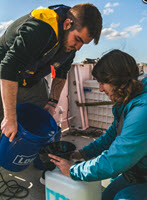
Dr. Peterson helped Matt think like a scientist, conduct objective investigations, and communicate his research with other scientists and the public. Matt credited Dr. Peterson’s faith in him as key to helping him grow as a scientist. He also treasures Dr. Peterson’s professional and personal advice, which he expects will help in future endeavors.
Matt admired how scientists within the GoMRI community help one another, such as when ECOGIG Principal Investigator Dr. Mandy Joye served on his thesis committee and lent her expertise to their project. Matt also recalled how grateful he and his colleagues were when, during preparations for Tropical Storm Gordon, Dr. Leila Hamdan and her team safely secured gear that they stored at the University of Southern Mississippi’s Marine Research Center.
“None of this research would be possible without a massive amount of help. Dr. Peterson, his current graduate students (my labmates), the captain and crew of the R/V Point Sur, the Pelagic Research Services ROV team, and GoMRI’s funding for this project all made this research and the experiences I have had as a result possible,” said Matt. “I want to extend my gratitude to all these people and groups, and probably many more that I am forgetting right now, for all the effort they put into making this project a success. Science is never a one-person job.”
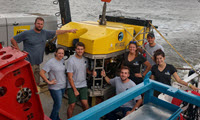
The two weeks that Matt spent at sea collecting oil samples was his most memorable experience where he dealt with the strenuous conditions aboard a research vessel, including seasickness, unusual sleep schedules, and showering during 11-foot swells. However, it was worth it to Matt to get first-hand deep-sea research experience. “The Gulf of Mexico is a beautiful, biodiverse, and economically critical body of water for both the United States and Mexico. Looking through the eyes (i.e., cameras) of the ROV was incredible. The sights that my colleagues and I were able to see on those two cruises are something that very few people get to experience,” he said. “Through this research, I’ve been given the opportunity to work towards protecting the Gulf, and I’m very grateful for that opportunity.”
His Future
Matt hopes to find a research position that includes travel, working in a dynamic setting, and being an active environmental steward. He suggests that students considering a scientific career get involved with research as early as possible, saying that the real learning happens through hands-on experience. “Whether that experience is in fieldwork, lab work, computer work, or a combination, working with real data and real samples to answer questions is what environmental science is all about,” he said. “Don’t let high-level mathematics and technical jargon intimidate you, like they initially did me. If you can think critically, proactively solve problems, and work hard, you can learn anything you put your mind to.”
Praise for Matt
Dr. Peterson praised Matt’s critical and creative thinking skills and his ability to make the research his own as he discovered novel insights and developed creative hypotheses. “Matt’s enthusiasm drives him every single day to learn more, try new analyses, and improve his skills. He never bends to adversity – in fact, he uses it as motivation!” said Dr. Peterson. “I’m proud of the scientist that Matt has become while working on his master’s thesis through this GoMRI project!”
The GoMRI community embraces bright and dedicated students like Matthew Kurpiel and their important contributions. The GoMRI Scholars Program recognizes graduate students whose work focuses on GoMRI-funded projects and builds community for the next generation of ocean science professionals.
By Stephanie Ellis and Nilde Maggie Dannreuther. Contact sellis@ngi.msstate.edu for questions or comments.
************
The Gulf of Mexico Research Initiative (GoMRI) is a 10-year independent research program established to study the effect, and the potential associated impact, of hydrocarbon releases on the environment and public health, as well as to develop improved spill mitigation, oil detection, characterization and remediation technologies. An independent and academic 20-member Research Board makes the funding and research direction decisions to ensure the intellectual quality, effectiveness and academic independence of the GoMRI research. All research data, findings and publications will be made publicly available. The program was established through a $500 million financial commitment from BP. For more information, visit https://gulfresearchinitiative.org/.
© Copyright 2010-2019 Gulf of Mexico Research Initiative (GoMRI) – All Rights Reserved. Redistribution is encouraged with acknowledgement to the Gulf of Mexico Research Initiative (GoMRI). Please credit images and/or videos as done in each article. Questions? Contact web-content editor Nilde “Maggie” Dannreuther, Northern Gulf Institute, Mississippi State University (maggied@ngi.msstate.edu).
